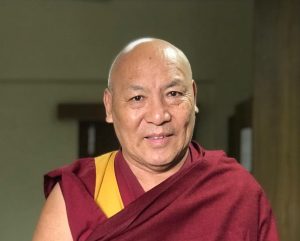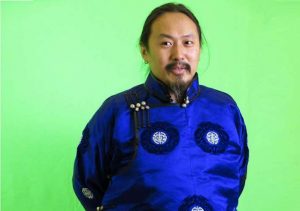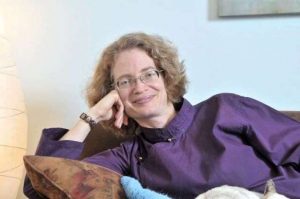
The real benefit of studying the Buddha’s teachings and the statements of enlightened masters is to be inspired to change the way we think, speak, and behave, which will make us more civil, gentle, and peaceful. When we thoroughly investigate the value of the meaning presented, it becomes obvious that we can become free—each and every one of us. — Chökyi Nyima Rinpoche
Chökyi Nyima Rinpoche is considered to be one of the greatest living masters of the Dzogchen or “Great Perfection” tradition of Vajrayana Buddhism—a gentle yet imposing figure whose warmth and presence easily fill any chamber or hall.
The eldest son of the revered Dzogchen master Kyabje Tulku Urgyen Rinpoche and the devoted practitioner Kunsang Dechen, Chökyi Nyima Rinpoche was born in Tibet in 1951. He was recognized as the seventh incarnation of the Drikung Kagyu lama Gar Drubchen, a Tibetan mahasiddha and an emanation of the second-century Indian Buddhist philosopher Nagarjuna.
Following the invasion of Tibet, Rinpoche spent his youth in India, studying for 11 years under the care of His Holiness the 16th Gyalwang Karmapa at Rumtek Monastery. He also studied and practiced under the venerated masters Dilgo Khyentse Rinpoche, Dudjom Rinpoche, Khunu Lama Tenzin Gyaltsen, as well as his own father, Tulku Urgyen Rinpoche.
In 1974, Rinpoche joined his parents in Kathmandu, where he assisted them in establishing Ka-Nying Shedrub Ling, a monastery on the outskirts of the city, just a short walk from the benevolent gaze of the venerable Boudhanath Stupa. Rinpoche became the abbot of Ka-Nying Shedrub Ling in 1976, at the age of just 25, and has since overseen the welfare and spiritual education of many hundreds of male and female monastics.
Ka-Nying Shedrub Ling, a dedicated sanctuary for studying and practicing the Buddhadharma, lies at the heart of Rinpoche’s growing mandala of Dharmic activities. Among his numerous initiatives and projects, Rinpoche, now 72 years old, has authored several books and founded a network of meditation centers around the world.
In 1997, Chökyi Nyima Rinpoche established the Rangjung Yeshe Institute within the grounds of Ka-Nying Shedrub Ling. The institute affiliated with Kathmandu University in 2002 to form the Center for Buddhist Studies. Today, the center offers a range of courses at various levels, including BA, MA, and PhD degrees in Buddhist studies and Himalayan languages, with classes held at the monastery’s monastic college.
When Buddhistdoor Global had the privilege of sitting down with Chökyi Nyima Rinpoche within Ka-Nying Shedrub Ling, he shared some of his reflections about Buddhism in the 21st century and his thoughts on the essential fundamental import of compassion as a foundational aspect of Buddhist practice.
“All sentient beings have within our minds loving-kindness—we all have that, everybody has; all sentient beings,” Rinpoche explained, smiling gently. “Broadly speaking, Buddhist practice is based on kindness; Buddhist ethics are based on kindness. In general, in Buddhist practice we talk about sila, samadhi, and prajna [Skt: moral virtue, meditative consciousness, and spiritual wisdom]. Sila, then, means ethics. Ethics means not harming anyone. What does it mean to harm? The five negative actions: killing; stealing; sexual misconduct; drinking or drugs that disturb the mind; and lying. This is a natural law and we all know that! This is not even necessarily a uniquely Buddhist way of practice; this is a natural, necessary thing.
“Each country may have its own laws or its own constitution that mention these points. But when people do not follow them . . . that’s why so many painful things have been created: why do we need laws? Why do we need judges? Why do we need jails? Why do we need armies and police and so many awful weapons? Because we don’t behave naturally and follow this natural law, which is based on kindness.”

Rinpoche went on to detail the emphasis placed on loving-kindness and compassion in the Mahayana tradition—in particular on cultivating effortless love and impartial love.
“Because all sentient beings are your own father and mother, and as such we need to help and serve all sentient beings!” he laughed. “Whether they hate you or love you, you need to help them, to serve them. You should never ever be angry, never ever hurt them. It might be very difficult, but it’s very logical!
“Broadly speaking, in Mahayana, the two most important principals are, in Sanskrit, karuna and sunyata,” Rinpoche explained.
“Karuna or mahakaruna means great compassion or great love. But what do we mean by great? We need to explain this clearly: great means including everyone—those who love you, those who hate you—and serving and helping them equally. This is extremely difficult but, at the same, time this is extremely important. And if you can be successful at that, then deep realization will be easy to attain!
“This is why we say that the supreme method is loving-kindness and compassion, and supreme wisdom is mahasunyata. These are key!” Rinpoche smiled here, raising a signifying finger.
Rinpoche then turned his attention to the conditions of the modern world: the ever-present danger that could see the Buddhist teachings become diluted, misunderstood, or even lost amid the capitalistic and materialistic obsessions of contemporary society, and the difficulty that young people today have in connecting with the Buddhadharma.
“Well, this very much depends on us, you know—how we preserve and present the Buddhadharma and how we handle it now,” Rinpoche observed, his voice taking on a more solemn timbre. “But there is a danger, you’re right. And this is also because there are many fake teachers; it can become difficult for people to distinguish which are the real teachings.”
Rinpoche briefly recalled some of the revered teachers on his own path. “I can say that whomever is born in Tibet, and grows up in Tibet, and studies in Tibet, their knowledge is very pure and very genuine and, I can say, unpolluted,” he noted emphatically. “They may not even know how to dial a telephone, yet their knowledge is so profound and high and pure . . .”
Nevertheless, Rinpoche expressed his own firm conviction in the capacities of younger generations to receive the teachings and practices of the Mahayana and Vajrayana.
“Western students are very smart,” he said. “One reason is because of their modern educational background. Their problem is science: the scientific mind can be good and bad. Because scientists, with their way of thinking . . . whatever doubts they may have, they like to ask questions and they want to get a logical answer!”
Rinpoche continued: “The majority of the world’s religions say there is a creator who created, while science says this is totally wrong: there’s no ‘creator’ . . . how do you know there’s a creator? Who created the creator?
“In this respect, the scientific mind is similar to the Tibetan Buddhist method of debate. Where Buddhism is more analytical in investigating the mind, science is more about investigating objects. So because of this shared perspective, science and Buddhism have become more and more friendly!” he exclaimed with laughter.
Rinpoche recalled the teaching he had given in Ka-Nying Shedrub Ling’s main temple earlier that same day, during which he had underscored the importance of combining study of the Dharma with Buddhist practice, observing that neither practice without study, nor study without practice can bring one to realize the Buddhadharma.
“When many people look at Buddhism, what they see is doing pujas, performing rituals, and so on, and they think that this is Buddhism,” Rinpoche noted. “Yes, this is an aspect of Buddhism, but this is merely the method. We often think, ‘I want to go to practice somewhere’—maybe in a temple or on a mountain, but this body is our retreat house and the mind is the retreatant. Practice here.
“Your work can also be a form of practice in your daily life,” he told me.
“I think [that students today] really need to study the teachings well to make sure they have no doubts. In this way, if the road is clear, then it’s easy to walk. If the path is not clear, then there can be very big trouble. Studying makes sure that our path is clear and our practice then is to walk.”
See more
Related features from BDG
Bodhicitta and the Buddhadharma: An Interview with His Holiness the 41st Sakya Trizin
The Chöd Cham of Nagi Gompa: An Alchemy of Radical Courage and Compassion
Kyabjé Tsikey Chökling Rinpoche (1953–2020) – Tender Recollections of a Marvelous Life
Book Review: Sadness, Love, Openness: The Buddhist Path of Joy
The Mahaparinirvana Ceremony of His Holiness Chatral Sangay Dorje Rinpoche
The Importance of the Five Precepts: An Interview with Chökyi Nyima Rinpoche
Related news reports from BDG
His Holiness the 41st Sakya Trizin Visits Nepal for the First Time Almost a Decade
84000 Announces Online Teaching with Chokyi Nyima Rinpoche on 1 August
Passing of His Holiness Dudjom Sangye Pema Shepa Rinpoche Announced
Live-streamed Concert for Buddhist Monastery and Nunnery in Nepal to Feature Norah Jones, Richard Gere, Laurie Anderson, and More
Ka-nying Shedrub Ling Announces Parinirvana of Tsikey Chokling Rinpoche
Rangjung Yeshe Gomde in California Offers Intensive Buddhist Studies Summer Program















